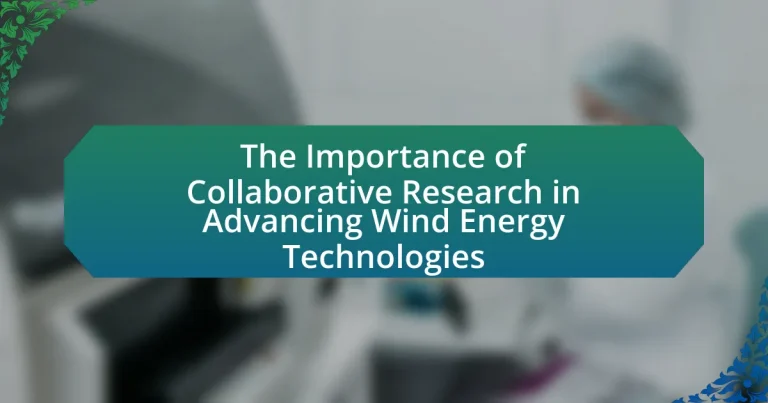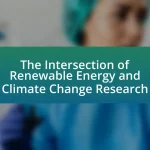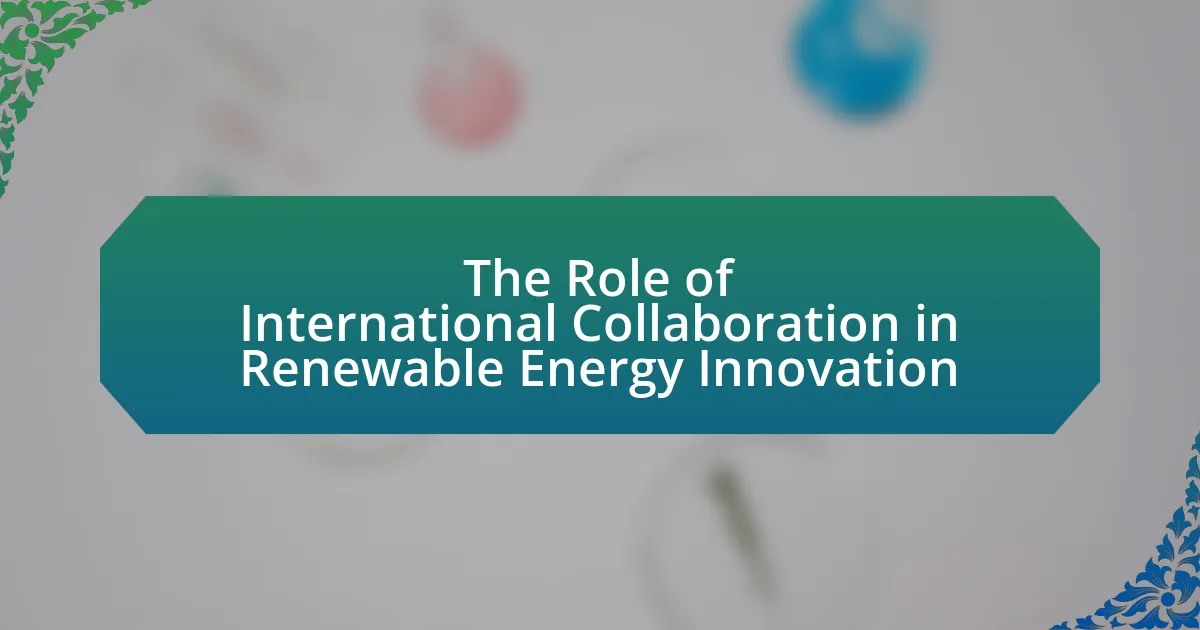The article focuses on the significance of collaborative research in advancing wind energy technologies. It highlights how partnerships among universities, industry leaders, and government agencies accelerate innovation, reduce costs, and enhance the development of efficient solutions in turbine design, energy storage, and grid integration. Key components of successful collaborations include clear communication, shared goals, and diverse expertise, which collectively address challenges such as high capital costs and regulatory hurdles. The article also discusses the role of joint research initiatives in shaping policies and regulatory frameworks, ultimately promoting sustainability and economic growth within the renewable energy sector.
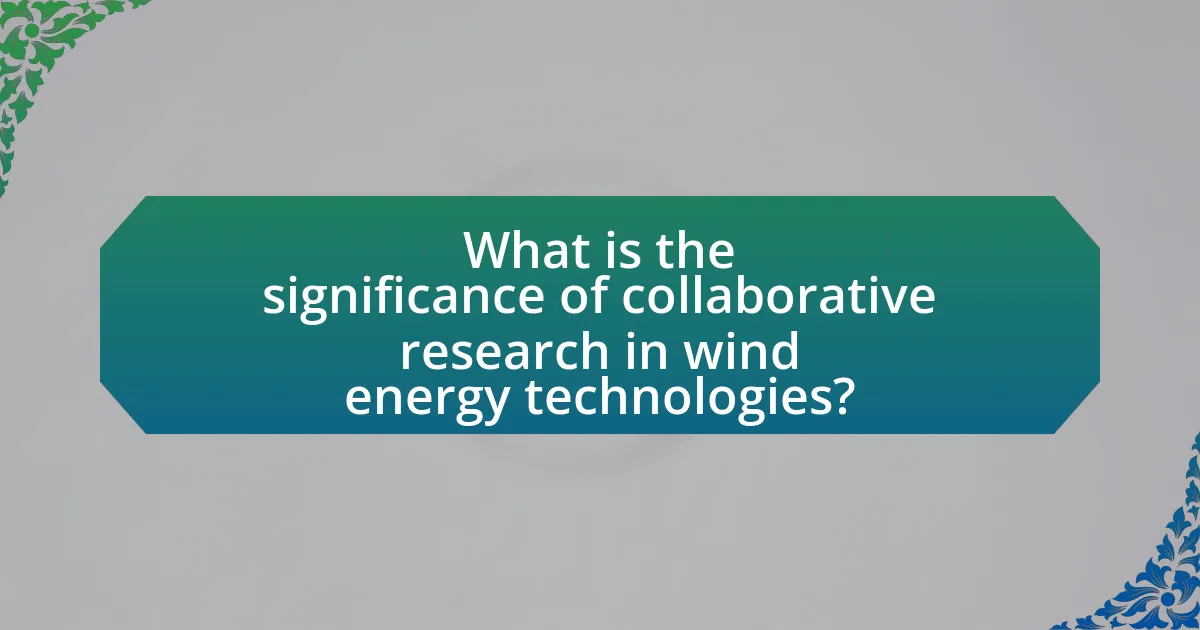
What is the significance of collaborative research in wind energy technologies?
Collaborative research in wind energy technologies is significant because it accelerates innovation and enhances the development of efficient solutions. By pooling resources, expertise, and data from various stakeholders, including universities, industry leaders, and government agencies, collaborative efforts lead to breakthroughs in turbine design, energy storage, and grid integration. For instance, the Global Wind Energy Council reported that collaborative projects have resulted in a 50% reduction in the cost of wind energy over the past decade, demonstrating the tangible benefits of shared knowledge and joint investment in research. This synergy not only fosters technological advancements but also promotes sustainability and economic growth within the renewable energy sector.
How does collaborative research enhance innovation in wind energy?
Collaborative research enhances innovation in wind energy by facilitating the sharing of knowledge, resources, and expertise among diverse stakeholders, including universities, industry players, and government agencies. This synergy accelerates the development of advanced technologies, as evidenced by projects like the Wind Energy Research Consortium, which combines efforts from multiple institutions to improve turbine efficiency and reduce costs. Such collaborations lead to breakthroughs in materials science and engineering, exemplified by the development of lighter and more durable turbine blades, ultimately driving the growth of the wind energy sector.
What are the key components of successful collaborative research initiatives?
Successful collaborative research initiatives are built on clear communication, shared goals, mutual respect, and diverse expertise. Clear communication ensures that all participants understand their roles and responsibilities, facilitating effective collaboration. Shared goals align the efforts of all stakeholders, driving the initiative towards a common purpose. Mutual respect fosters a positive working environment, encouraging open dialogue and the exchange of ideas. Diverse expertise brings together varied perspectives and skills, enhancing problem-solving capabilities and innovation. These components are essential for achieving impactful outcomes in collaborative research, particularly in advancing wind energy technologies, where interdisciplinary approaches are crucial for addressing complex challenges.
How do partnerships between academia and industry drive advancements?
Partnerships between academia and industry drive advancements by facilitating the exchange of knowledge, resources, and expertise, which accelerates innovation. For instance, collaborative research projects often lead to the development of new technologies and methodologies that can be rapidly implemented in real-world applications. A notable example is the collaboration between universities and companies in the wind energy sector, where academic research on turbine efficiency has directly influenced industry practices, resulting in a 20% increase in energy output in some cases. This synergy not only enhances the practical application of theoretical research but also ensures that academic findings are aligned with industry needs, thereby fostering a more dynamic and responsive innovation ecosystem.
Why is collaboration essential for addressing challenges in wind energy?
Collaboration is essential for addressing challenges in wind energy because it combines diverse expertise and resources to tackle complex technical, regulatory, and environmental issues. For instance, partnerships among researchers, industry stakeholders, and policymakers facilitate the sharing of innovative technologies and best practices, leading to more efficient turbine designs and improved energy output. A study by the National Renewable Energy Laboratory found that collaborative projects can reduce costs by up to 20% through shared knowledge and joint problem-solving efforts. This collective approach not only accelerates technological advancements but also enhances the overall sustainability and acceptance of wind energy solutions.
What specific challenges in wind energy can be mitigated through collaboration?
Collaboration can mitigate specific challenges in wind energy, such as high initial capital costs, technological innovation, and regulatory hurdles. By pooling resources and expertise, stakeholders can share the financial burden associated with developing wind projects, which often require significant upfront investment. Collaborative research initiatives can drive technological advancements, leading to more efficient turbine designs and improved energy output. Furthermore, partnerships among industry players, government agencies, and research institutions can streamline the regulatory process by aligning interests and facilitating knowledge sharing, ultimately accelerating project approvals and deployment.
How does collaboration facilitate knowledge sharing and resource optimization?
Collaboration facilitates knowledge sharing and resource optimization by creating an environment where diverse expertise and perspectives converge, leading to innovative solutions and efficient use of resources. In collaborative settings, individuals and organizations can pool their knowledge, share best practices, and leverage each other’s strengths, which enhances problem-solving capabilities. For instance, research conducted by the National Renewable Energy Laboratory highlights that collaborative projects in wind energy have resulted in a 20% increase in efficiency due to shared technological advancements and resource allocation. This synergy not only accelerates the development of new technologies but also reduces costs associated with research and development, demonstrating the tangible benefits of collaboration in advancing wind energy technologies.
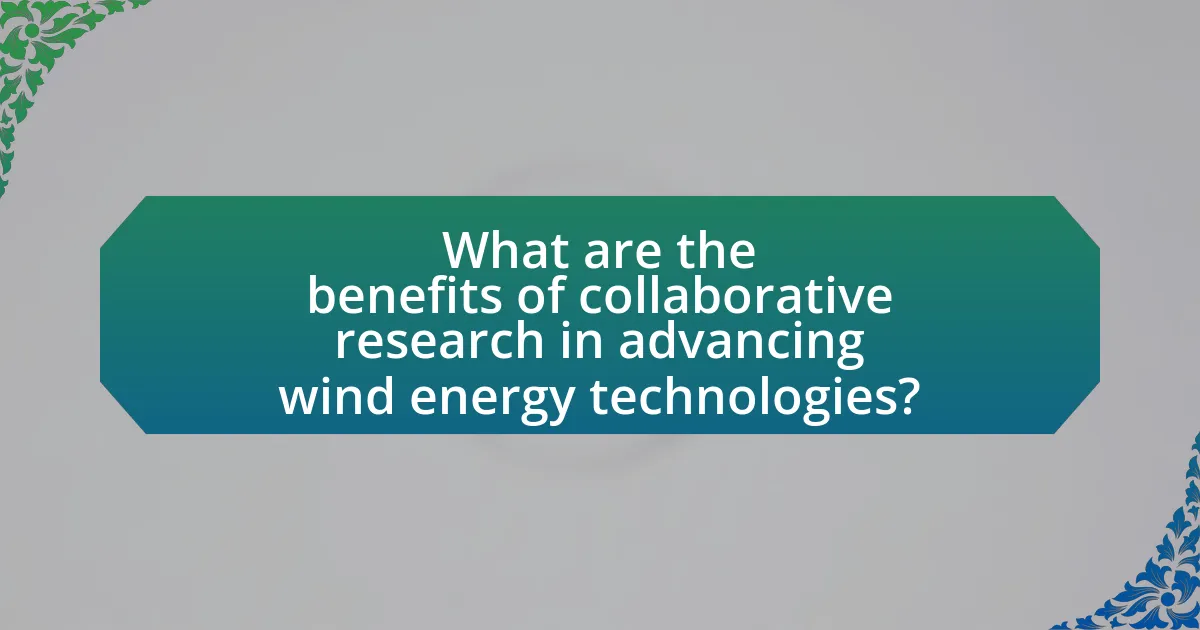
What are the benefits of collaborative research in advancing wind energy technologies?
Collaborative research significantly enhances the advancement of wind energy technologies by pooling resources, expertise, and innovative ideas from diverse stakeholders. This collaboration leads to accelerated development cycles, as seen in projects like the Wind Energy Research and Development Program, which combines efforts from universities, industry leaders, and government agencies to improve turbine efficiency and reduce costs. Furthermore, collaborative research fosters knowledge sharing, enabling participants to leverage each other’s findings and best practices, ultimately driving technological breakthroughs and increasing the competitiveness of wind energy in the global market.
How does collaborative research contribute to cost reduction in wind energy projects?
Collaborative research contributes to cost reduction in wind energy projects by pooling resources, expertise, and data among various stakeholders, which leads to more efficient project development and implementation. By sharing knowledge and best practices, organizations can minimize duplication of efforts and reduce research and development costs. For instance, studies have shown that collaborative efforts can lead to innovations in turbine design and materials, which can decrease manufacturing costs by up to 20%. Additionally, partnerships often facilitate access to funding and grants, further lowering financial barriers for wind energy initiatives.
What role does shared funding play in collaborative research efforts?
Shared funding is crucial in collaborative research efforts as it enables multiple stakeholders to pool resources, thereby enhancing the scope and impact of research projects. By distributing financial responsibilities among various partners, such as universities, government agencies, and private companies, shared funding facilitates access to a broader range of expertise and technologies. This collaborative financial model has been shown to increase the likelihood of successful outcomes, as evidenced by initiatives like the European Union’s Horizon 2020 program, which allocated over €80 billion for research and innovation, significantly advancing renewable energy technologies, including wind energy.
How can collaborative research lead to more efficient technology development?
Collaborative research can lead to more efficient technology development by pooling resources, expertise, and diverse perspectives, which accelerates innovation. For instance, partnerships between universities, industry leaders, and government agencies in wind energy research have resulted in significant advancements, such as the development of more efficient turbine designs and improved energy storage solutions. A study by the National Renewable Energy Laboratory found that collaborative projects in renewable energy can reduce development time by up to 30%, demonstrating that shared knowledge and joint problem-solving enhance the overall effectiveness of technology development efforts.
What impact does collaborative research have on policy and regulation in wind energy?
Collaborative research significantly influences policy and regulation in wind energy by providing evidence-based insights that shape decision-making processes. This type of research fosters partnerships among academia, industry, and government, leading to the development of comprehensive data on wind energy’s environmental and economic impacts. For instance, studies conducted by organizations like the National Renewable Energy Laboratory have demonstrated how collaborative efforts can lead to improved regulatory frameworks that enhance the deployment of wind energy technologies. Such research not only informs policymakers about best practices but also helps in addressing public concerns, ultimately facilitating smoother regulatory approvals and promoting sustainable energy initiatives.
How can joint research initiatives influence governmental policies?
Joint research initiatives can significantly influence governmental policies by providing evidence-based data that informs decision-making. For instance, collaborative studies on wind energy technologies can demonstrate the economic and environmental benefits of renewable energy, leading governments to adopt supportive regulations and funding for these initiatives. Research conducted by the International Renewable Energy Agency (IRENA) in 2021 highlighted that countries investing in wind energy saw a 20% reduction in carbon emissions, which can prompt policymakers to prioritize renewable energy in their agendas. Such initiatives not only generate credible research but also foster partnerships between academia, industry, and government, creating a unified approach to policy development that aligns with scientific findings and public interest.
What are the implications of collaborative research for regulatory frameworks?
Collaborative research significantly influences regulatory frameworks by fostering innovation and ensuring that regulations keep pace with technological advancements. This collaboration often leads to the development of new standards and practices that address emerging challenges in wind energy technologies. For instance, partnerships between academia, industry, and government can result in comprehensive data sharing, which informs policymakers about the latest advancements and safety protocols. A study by the National Renewable Energy Laboratory highlights that collaborative efforts in research have led to the establishment of more adaptive regulatory measures that enhance the efficiency and sustainability of wind energy projects.
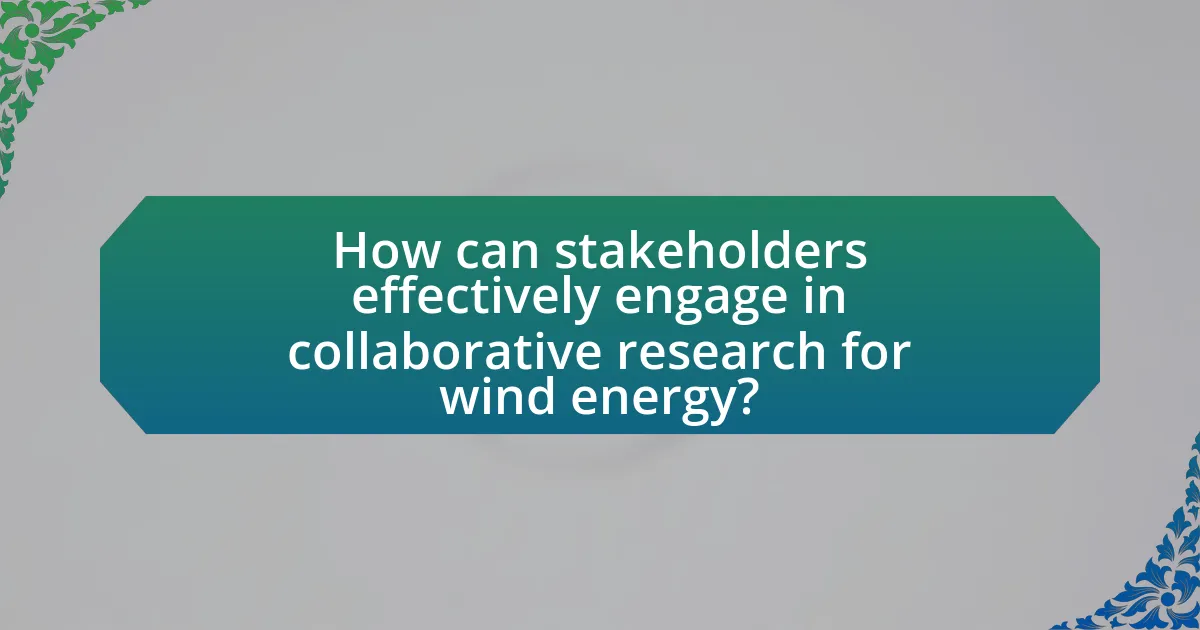
How can stakeholders effectively engage in collaborative research for wind energy?
Stakeholders can effectively engage in collaborative research for wind energy by establishing clear communication channels and shared goals. This approach fosters transparency and aligns the interests of various parties, including government agencies, private companies, and research institutions. For instance, the U.S. Department of Energy’s Wind Energy Technologies Office emphasizes the importance of partnerships in advancing technology and reducing costs, highlighting successful collaborations that have led to significant innovations in turbine design and efficiency. By leveraging diverse expertise and resources, stakeholders can enhance research outcomes and accelerate the deployment of wind energy solutions.
What strategies can organizations adopt to foster collaboration in wind energy research?
Organizations can adopt several strategies to foster collaboration in wind energy research, including establishing partnerships with academic institutions, creating interdisciplinary research teams, and leveraging public-private collaborations. Establishing partnerships with academic institutions allows organizations to access cutting-edge research and expertise, as seen in initiatives like the National Renewable Energy Laboratory’s collaborations with universities, which enhance innovation in wind technology. Creating interdisciplinary research teams encourages diverse perspectives and skills, leading to more comprehensive solutions; for example, projects that integrate engineering, environmental science, and economics have shown improved outcomes in wind energy assessments. Leveraging public-private collaborations, such as those facilitated by government funding programs, can also enhance resource sharing and accelerate the development of new technologies, as evidenced by the U.S. Department of Energy’s Wind Program, which supports collaborative research efforts across various stakeholders.
How can effective communication enhance collaborative research outcomes?
Effective communication enhances collaborative research outcomes by facilitating clear information exchange and fostering mutual understanding among team members. When researchers communicate effectively, they can align their goals, share insights, and address challenges promptly, which leads to more innovative solutions. Studies show that teams with strong communication practices are 25% more productive, as they can leverage diverse expertise and perspectives efficiently. This is particularly crucial in advancing wind energy technologies, where interdisciplinary collaboration is essential for addressing complex engineering and environmental challenges.
What tools and platforms are available to support collaborative research efforts?
Tools and platforms available to support collaborative research efforts include cloud-based services like Google Drive and Dropbox for file sharing, project management tools such as Trello and Asana for task coordination, and communication platforms like Slack and Microsoft Teams for real-time collaboration. These tools facilitate seamless interaction among researchers, enabling them to share data, manage projects, and communicate effectively, which is essential for advancing complex fields like wind energy technologies. Research indicates that using collaborative tools can enhance productivity and innovation in research projects, as evidenced by a study published in the Journal of Research Practice, which found that teams utilizing collaborative platforms reported a 30% increase in project efficiency.
What best practices should be followed for successful collaborative research in wind energy?
Successful collaborative research in wind energy should prioritize clear communication, defined roles, and shared goals among all stakeholders. Establishing a structured communication plan ensures that all participants are informed and engaged, which is critical for addressing complex challenges in wind energy projects. Clearly defined roles help to leverage the unique expertise of each collaborator, enhancing the overall effectiveness of the research team. Additionally, setting shared goals aligns the efforts of diverse partners, fostering a unified approach to innovation and problem-solving. Research indicates that projects with well-defined collaboration frameworks are more likely to achieve significant advancements in technology and efficiency, as seen in initiatives like the Wind Energy Technologies Office’s collaborative projects, which have led to substantial improvements in turbine design and energy output.
How can stakeholders measure the success of collaborative research initiatives?
Stakeholders can measure the success of collaborative research initiatives by evaluating specific metrics such as the number of patents filed, publications produced, and the implementation of research findings in practical applications. For instance, a study by the National Renewable Energy Laboratory indicated that collaborative projects in wind energy resulted in a 30% increase in patent filings compared to non-collaborative efforts. Additionally, stakeholders can assess the impact of these initiatives through feedback from industry partners and the extent to which research outcomes contribute to advancements in wind energy technologies, such as improved turbine efficiency or reduced costs. These metrics provide concrete evidence of the effectiveness and value of collaborative research efforts.
What common pitfalls should be avoided in collaborative research projects?
Common pitfalls to avoid in collaborative research projects include poor communication, lack of clear roles, and inadequate conflict resolution strategies. Poor communication can lead to misunderstandings and misalignment of goals, which is critical in projects involving multiple stakeholders. A study by the National Academy of Sciences highlights that effective communication is essential for successful collaboration, as it fosters trust and clarity among team members. Additionally, not defining clear roles can result in overlapping responsibilities or gaps in accountability, which can hinder project progress. Lastly, failing to establish conflict resolution mechanisms can exacerbate disagreements, ultimately affecting the project’s outcomes. Addressing these pitfalls is vital for enhancing the effectiveness of collaborative research in advancing wind energy technologies.
What are the future trends in collaborative research for wind energy technologies?
Future trends in collaborative research for wind energy technologies include increased partnerships between academia, industry, and government entities to accelerate innovation and deployment. Collaborative efforts are focusing on integrating advanced materials, such as lightweight composites and smart sensors, to enhance turbine efficiency and durability. Additionally, there is a growing emphasis on data sharing and joint research initiatives aimed at optimizing wind farm operations through artificial intelligence and machine learning. For instance, the International Energy Agency reports that collaborative research can lead to a 20% reduction in costs and a significant increase in energy output by 2030. These trends highlight the critical role of collaboration in driving advancements in wind energy technologies.
How will emerging technologies shape collaborative research in wind energy?
Emerging technologies will significantly enhance collaborative research in wind energy by facilitating data sharing, improving modeling accuracy, and enabling real-time monitoring. Technologies such as artificial intelligence and machine learning allow researchers to analyze vast datasets from wind farms, leading to better predictive models for energy output and maintenance needs. For instance, the integration of IoT devices in turbines provides continuous performance data, which can be shared across research institutions, fostering collaboration and innovation. Additionally, blockchain technology can streamline the sharing of research findings and intellectual property, ensuring transparency and trust among collaborators. These advancements not only improve the efficiency of research efforts but also accelerate the development of more effective wind energy solutions.
What role will international collaboration play in advancing wind energy technologies?
International collaboration will significantly accelerate the advancement of wind energy technologies by pooling resources, expertise, and innovative practices from diverse countries. Collaborative efforts enable countries to share research findings, develop standardized technologies, and implement best practices, which can lead to more efficient and cost-effective wind energy solutions. For instance, the International Energy Agency (IEA) reported that global cooperation in research and development can reduce the cost of wind energy by up to 30% by 2030. This collaborative approach not only fosters technological innovation but also enhances the deployment of wind energy systems worldwide, contributing to global sustainability goals.
What practical steps can organizations take to initiate collaborative research in wind energy?
Organizations can initiate collaborative research in wind energy by establishing partnerships with academic institutions, industry stakeholders, and government agencies. These partnerships can facilitate resource sharing, knowledge exchange, and access to funding opportunities. For instance, the U.S. Department of Energy’s Wind Energy Technologies Office has successfully collaborated with universities and private companies to advance wind technology through joint research initiatives. Additionally, organizations should create joint research proposals that align with national energy goals, ensuring that projects receive support and visibility. Engaging in industry consortia, such as the Global Wind Energy Council, can also enhance collaboration by providing a platform for sharing best practices and research findings.
